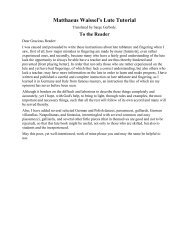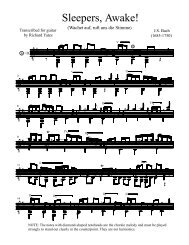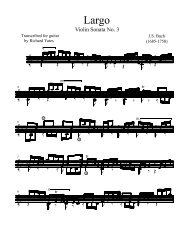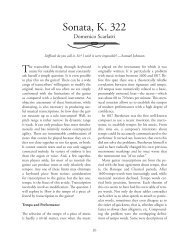The Transcriber's Art - Richard Yates Classical Guitar Transcriptions
The Transcriber's Art - Richard Yates Classical Guitar Transcriptions
The Transcriber's Art - Richard Yates Classical Guitar Transcriptions
Create successful ePaper yourself
Turn your PDF publications into a flip-book with our unique Google optimized e-Paper software.
<strong>The</strong> Transcriber’s <strong>Art</strong> - #46<br />
<strong>Richard</strong> <strong>Yates</strong><br />
<strong>The</strong> Manchester Gamba Book<br />
“He who shall Neglect, or be Ignorant in the Way of the Right Playing<br />
such Compositions … must needs be counted Deficient in Judgment, and<br />
Skill; and not fit to be owned, as a Master, or Teacher.”<br />
—Thomas Mace, Musick’s Monument, 1676<br />
A century ago Dr. Henry Watson of Manchester, an enthusiast of old music, purchased<br />
from an amateur musician of Kew a manuscript even then nearly three hundred years old.<br />
It contained more than two hundred solos for the lyra-viol meticulously organized and<br />
transcribed by an unknown hand. History has preserved neither the details of the<br />
transaction nor the provenance of the manuscript, but it provides us with both excellent<br />
music and a window into a time dominated by an instrument now all but forgotten.<br />
Watson himself wrote: “This much can be said of the viol that cannot be said of any<br />
one who plays the small tune of historian to it: that it lived some hundreds of years ago, a<br />
happy, generous, cheery, domesticated life; that it died lamented; and that it left behind it<br />
not only a pleasant memory, but an offspring and an offshoot that have enriched the<br />
world of music beyond all estimation.”<br />
<strong>The</strong> Manchester Gamba Book<br />
<strong>The</strong> manuscript volume that Dr. Watson purchased was left, after his death in 1911, to the<br />
City of Manchester, England, where it resides today. In 1978 Paul Furnas completed a<br />
transcription and analysis of it while he was a graduate student at Stanford University,<br />
and the facsimile, with his introduction, is available from Peacock Press. His<br />
investigation of ornamentation is especially useful for anyone approaching this music.<br />
<strong>The</strong> collection draws on the compositions of the brighter lights of the time—John<br />
Jenkins, William Lawes, Alfonso Ferrabosco—as well as those more obscure. At least<br />
one composer is known to history solely through the six pieces in this manuscript. <strong>The</strong><br />
pieces are organized in groups, progressively, by tuning—22 different systems in all.<br />
Lyra-viol<br />
Just a few issues ago, Soundboard (Vol. XXXV, No. 2) included an article about the lyraviol<br />
by Olga Amelkina-Vera. That excellent introduction for guitarists obviates a lengthy<br />
description here. (Readers who do not have access to that issue can find the article, in the<br />
form of her DMA dissertation, at her website: www.kitharaduo.com.)<br />
One characteristic—perhaps even a defining one—of lyra-viol music is the use of<br />
many different tunings. While “Viol Way” tuning, identical to that of the Renaissance<br />
lute, was common, many other exotic forms were tried—more than 60 are known today.<br />
Despite Mace’s claim that all possibilities had been exhausted, modern guitar tuning was
apparently overlooked. <strong>The</strong> closest one seems to have been the modern guitar variant in<br />
which the fifth string is tuned to G and the sixth to D. <strong>The</strong> music of Tobias Hume,<br />
described and transcribed in Dr. Amelikina-Vera’s article, used Viol Way tuning, which<br />
is familiar to most guitarists from the rich legacy of the Renaissance lute.<br />
However, over time lyra-viol tunings evolved toward more resonant ones, that is,<br />
tunings that sounded the notes of triads and that fingerstyle guitarists today call “open”<br />
tunings. This probably occurred because of the idiosyncrasies of the lyra-viol itself. As a<br />
bowed instrument, its polyphonic capabilities were rather restricted. Specifically, any<br />
simultaneous notes, whether in a chord or through the coincidence of contrapuntal voices,<br />
had to be played on adjacent strings. Tunings were selected to minimize this constraint<br />
and to maximize the sympathetic resonance from the other strings.<br />
Also characteristic of the lyra-viol was a technique that went by the name of “<strong>The</strong><br />
Rule of Holds.” Christopher Simpson explained it like this in 1659: “When you set a<br />
Finger down, you are to let it rest there, (Playing the following Notes with other Fingers)<br />
until some occasion require the removing of it. This is done … to continue the sound of a<br />
Note when the Bow hath left it.” Thomas Mace, in his typically dyspeptic way<br />
complained that performers “seldom Hold their Hands according to the Propriety, and<br />
Necessity of the Composition … This Error … is the Grosest that can be Committed in<br />
the Kind …”<br />
So both the selection of tuning and the Rule of Holds helped in two ways: to allow<br />
sounded notes to continue to ring—thus facilitating independence of voices—and also to<br />
promote general resonance of the instrument. This limitation of the lyra-viol is especially<br />
significant for guitar transcriptions. After all, every sound that issues from our instrument<br />
happens after “the Bow [or in our case, finger] hath left it,” and since we cannot<br />
rummage around to find obliging tunings, close attention to the assignment of notes to<br />
fingers and strings is essential.<br />
Tuning systems<br />
Before turning to specific transcription examples and solutions, a brief explanation of<br />
notation is in order. Lyra-viol tablature uses letters to indicate frets: a= open string,<br />
b=first fret, c=second, etc. Tuning systems use these letters to list the frets at which<br />
strings are stopped to produce unisons. For instance, on the guitar we stop the second<br />
string at the fifth fret to make a unison with the first string; we stop the third string at the<br />
fourth fret, and so on. Shorthand for our guitar tuning could thus be written 54555 or,<br />
using letters for the frets, fefff. Similarly, “drop-D” tuning is feffh, and Renaissance lute<br />
tuning is ffeff. Without a lot of familiarity with these tunings they can be obscure to<br />
compare in writing, so for this article I will also translate them into actual note pitches.<br />
<strong>Guitar</strong>s are normally tuned “e 1 bgdAE.” For easy comparison I will always start with the<br />
first string and assume that it is the note “e 1 ” that we normally use. Please note that this is<br />
only to make tunings easy to compare and should not be literally tried on your guitar.<br />
Some tunings written in this form would pitch some strings high enough to cause damage<br />
to strings or bridges. If you want to try different tunings, and I strongly recommend you
do, adjust the actual pitches lower, starting a whole step lower with “d 1 ” works well in<br />
most cases.<br />
<strong>The</strong> duration problem<br />
Tablature does not show how long to hold notes in contrapuntal textures so it is common<br />
to read that in order to render a score in standard notation one must “infer the implied<br />
counterpoint.” While this is true enough as a general procedure, there are pitfalls as well.<br />
<strong>The</strong> transcription of Melchior Neusidler”s Salterello (antico) in the same issue of<br />
Soundboard noted above gives examples of the ways this general plan can diverge in<br />
various hands. And that happens with Renaissance lute tablature where the tuning is quite<br />
close to the guitar. <strong>Transcriptions</strong> of that music nearly always retain the same relative key<br />
and simply realize one implied voice in one place while losing another nearby. <strong>The</strong> task<br />
is more complicated when transcribing tablature in more distant tunings.<br />
Also, transcribers looking for implied counterpoint sometimes assume there is a real<br />
counterpoint to uncover, lurking among the notes. As Henry Watson himself put it, “We<br />
are apt in music as in other things to discover causes and to trace sequences where none<br />
exist.” So a slavish tracing of an implied contrapuntal voice may infer far more than the<br />
composer conceived. In style brisé, counterpoint is often a compelling illusion, not<br />
simply a concession to the instrument”s limitations.<br />
Still, it is necessary to figure out when and how to “Hold [our] Hands according to<br />
the Propriety, and Necessity of the Composition,” and close attention to the assignment<br />
of notes to strings is a key. In lyra-viol music it is rare to find one voice cut too short by<br />
another voice intruding on the same string. <strong>The</strong> skill of these composers was in<br />
integrating tuning systems with composition in order to facilitate counterpoint. <strong>The</strong>ir<br />
cleverness is one hallmark of lyra-viol music and undoubtedly the motivation for so<br />
many different tunings. I will elaborate on this with examples in the notes for each piece.<br />
Selected pieces<br />
<strong>The</strong> seven pieces presented here were selected to highlight a variety of different tunings.<br />
<strong>The</strong>y are all small in scale and of relatively low technical difficulty. While some lyra-viol<br />
music benefits from a filling out of harmonies to compensate for the original instrument’s<br />
limitation of playing simultaneous notes being on adjacent strings, I felt that the pieces<br />
here stand well on their own. Indeed, they demonstrate how skillfully that limitation can<br />
be overcome. <strong>The</strong> Roman numerals in parentheses refer to the section of the manuscript<br />
from which they were drawn. <strong>The</strong> original tuning is given in tablature shorthand as well<br />
as modern pitch names.<br />
Saraband, John Jenkins, X-9 (efdef), e 1 c 1 gecG, French Sette<br />
John Jenkins (1592–1678) was one of the best known musicians of his time, specializing<br />
in consort music, much of it for viols. His Saraband is a little primer in the Rule of<br />
Holds. <strong>The</strong> tuning forms an open major triad quite different from guitar tuning, and is<br />
designed to emphasize the over-ringing of notes to form vertical sonorities. <strong>The</strong>
assignment of notes to strings in the tablature, combined with the Rule of Holds, can help<br />
guide the transcription. Taking the Rule of Holds literally gives this result:<br />
While this is more detail than is needed or practical in a guitar transcription, I did it<br />
this way to demonstrate the Rule of Holds and to give a feel for the style and technique of<br />
playing these pieces. <strong>The</strong> full score is more restrained in its notation although the<br />
fingering is the same. <strong>The</strong> bass notes at the asterisks were transposed up one octave.<br />
Untitled, Anonymous, XVI-1 (edeff), e 1 c 1 afcG<br />
Scarcely longer than a ring tone, this charming piece presents no special problems in<br />
deciphering its texture. <strong>The</strong> inversion of the arpeggio figures from the first half to the<br />
second makes a pleasing symmetry. Certainly, the intent is to allow the notes of these<br />
arpeggios to ring over each other. A fussy separation of the durations in the notation is<br />
not necessary, as holding these notes is second nature to guitarists.<br />
Coranto, Alfonso Ferrabosco (ii), III-8 (fefhf) e 1 bgdGD, Lyra Waye<br />
Ferrabosco (1575–1628) was an English composer and viol player of Italian descent. Of<br />
his generation in England, he was arguably the most accomplished, innovative and<br />
influential composer of chamber music for viols, and of songs for court masques. This<br />
Coranto has a muscular, driving momentum. <strong>The</strong> tuning system, “Lyra Waye,” is not<br />
entirely foreign to guitarists.
Almaine, John Jenkins, XI-24 (edfhf), e 1 c 1 aeAE, Harpe Sette Flat<br />
<strong>The</strong> tuning was used primarily for minor key pieces. A related tuning used the equivalent<br />
of a C sharp for the second string and was called, unsurprisingly, “Harpe Sette sharp”.<br />
In measure five the asterisks mark two notes that were probably errors in the<br />
tablature, where they were written for the open fifth and fourth string instead of for the<br />
sixth and fifth. This is one of the most common errors in tablature manuscripts—the right<br />
symbol on the wrong string.<br />
Untitled, Stephen Goodall, I-16 (ffeff) e 1 bf#dAE, Violl Waye<br />
<strong>The</strong>re are six pieces by Stephen Goodall in <strong>The</strong> Manchester Gamba Book but, aside from<br />
this small sample, nothing else is known about his life or music. <strong>The</strong> untitled piece<br />
included here is the only one in Renaissance lute tuning. Because of the similarity to<br />
guitar tuning, transcription is usually straightforward (but this does not imply that it<br />
always works well!). <strong>The</strong> interesting feature of this piece is that it avoided the first string<br />
of the lyra-viol entirely. <strong>The</strong> tuning of the remaining five strings is feff which is identical<br />
to the first five strings of the guitar! This meant that transcription required no changes to<br />
the original at all, just that it be transposed a perfect fourth higher. <strong>The</strong> result is a<br />
remarkably delicate set of divisions that I find reminiscent of the clavichord and that<br />
would be marred by a pedestrian addition of lower bass notes to “fill it out.”<br />
Note the use of two different types of hemiola. <strong>The</strong> first one closes the opening and<br />
second statements where the 3/4 meter becomes 6/8 in measure 7. <strong>The</strong>n in the third and<br />
fourth statements, a larger-scale hemiola occurs where two measures of 3/4 become the<br />
equivalent of one measure of 3/2.<br />
Paven, Joseph Sherlie, III-11 (fefhf), e 1 bgdGD, Lyra Waye<br />
Sherlie (fl. London, 1607–10) has a surviving output comprising just 20 lyra-viol pieces<br />
that are similar in style to the dances of Alfonso Ferrabosco. <strong>The</strong> Paven is a dance in<br />
duple meter usually with a sedate character and a regular metrical structure. It was a<br />
common form for English composers until about 1625.<br />
Another characteristic of some lyra-viol music is a specialized set of ornaments or<br />
“graces,” although in the pieces presented here the only one is the grace note in measure<br />
three. <strong>The</strong> term for this one was a “backfall.” <strong>The</strong> trill in measure 10 was written out in<br />
this manuscript but could as easily have been written with a sign for a “shaked backfall<br />
and relish.”<br />
Untitled, John Jenkins, XIII-4 (fdefh), e 1 bg#eBE, High Harp Way sharp<br />
This piece was also written for an open tuning, and was easily dissected into a throughcomposed<br />
two-voice texture. This means that the leaps in the top line are melodic, not<br />
contrapuntal, and the fingering can be arranged to facilitate their execution. Specifically,<br />
it is helpful to play them on a single string to prevent the ringing over of the first note that<br />
might otherwise cloud the line. And so in several spots the note E is assigned to the<br />
second string rather than the open first string. In performance, playing the first notes of<br />
these leaps a bit staccato can clarify the gesture. <strong>The</strong> trills are editorial, but characteristic.
<strong>The</strong> base line beginning at the asterisk has been transposed up an octave. It could be<br />
played at pitch with a drop-D tuning.<br />
Further resources<br />
For more adventuresome readers, I have posted a file of the original tablature of these<br />
pieces along with transcriptions for Renaissance lute tuning. Trying a few of the unusual<br />
tunings can give a feel for this music much more quickly than the wordy descriptions<br />
here. <strong>The</strong> file is at: www.yatesguitar.com/Manchester.pdf.<br />
Dr. Amelkina-Vera’s dissertation can be downloaded from www.kitharaduo.com.<br />
<strong>The</strong> facsimile of <strong>The</strong> Manchester Gamba Book with an introduction by Dr. Furnas (there,<br />
inexplicably, spelled “Furness”) is published by Peacock Press in West Yorkshire,<br />
England.<br />
Dr. Furnas’ analysis and transcription is in: “<strong>The</strong> Manchester Gamba Book: a primary<br />
source of ornaments for the lyra viol," Furnas, Paul Lindley, Dissertation, Stanford, 1978.<br />
More music and information about the lyra-viol can be found at www.vdgsa.org.<br />
<strong>Richard</strong> <strong>Yates</strong><br />
www.yatesguitar.com<br />
richard@yatesguitar.com
Saraband<br />
John Jenkins<br />
X-9 (efdef)<br />
V8 3 ‰ œ œ œ.<br />
œ .<br />
œ<br />
J<br />
œ .<br />
œ<br />
J<br />
œ.<br />
.<br />
œ œ Œ<br />
œ.<br />
œ<br />
J .<br />
V Œ<br />
œ.<br />
.<br />
J<br />
œ 3<br />
œ J œ .<br />
2 œœ..<br />
œ œ œ.<br />
œ<br />
œ.<br />
J<br />
œ<br />
3<br />
h<br />
j j<br />
1 Jœ<br />
4 œ<br />
J œ œ<br />
œ œ œ œ.<br />
‰<br />
J J œ<br />
œ J œ 1<br />
7<br />
III<br />
15<br />
œ.<br />
V .<br />
22<br />
V<br />
29<br />
.<br />
V<br />
37<br />
œ<br />
J œ œ ‰<br />
3œ<br />
J<br />
œ œ œ<br />
Œ œ œ œ.<br />
‰ œ<br />
#œ<br />
œ<br />
.<br />
œ œ 1<br />
Œ.<br />
œ<br />
3<br />
h<br />
2<br />
1<br />
œ<br />
h<br />
V œ.<br />
.<br />
œ J œ .<br />
œ<br />
J œ<br />
<strong>The</strong> Manchester Gamba Book<br />
Seven Selected Pieces<br />
transcribed by <strong>Richard</strong> <strong>Yates</strong><br />
œ<br />
œ V 3<br />
œ œ<br />
J<br />
œ œ<br />
III<br />
œ œ œ œ œ<br />
œ.<br />
œ œ œ œ.<br />
j<br />
œ<br />
Œ<br />
4<br />
0<br />
3œ<br />
# œ nœ<br />
# œ.<br />
œ œ<br />
.<br />
.<br />
#<br />
œ. œ<br />
III<br />
œ.<br />
œ.<br />
œ œ œ<br />
œ.<br />
œ.<br />
œ.<br />
‰<br />
œ 3œ<br />
J<br />
1œ<br />
J<br />
3<br />
.<br />
œ<br />
œ.<br />
j<br />
œ<br />
œ.<br />
œ<br />
œ.<br />
1 œ<br />
œ<br />
œ<br />
. œ œ<br />
0 œœ.<br />
œ J œ *<br />
œ<br />
J<br />
œ œ œ 4<br />
œ.<br />
œ.<br />
œ<br />
œ.<br />
œ<br />
œ œ.<br />
œ.<br />
4 .<br />
œ<br />
J<br />
*<br />
œ 2 œ<br />
œ.<br />
J œ œ<br />
II 4<br />
œ<br />
. œ. œ<br />
J œ 2<br />
œ<br />
J<br />
œ<br />
J<br />
3<br />
1œ<br />
J œ<br />
Untitled<br />
Anonymous<br />
XVI-1 (edeff)<br />
V # # c œ œ<br />
Œ<br />
˙œ œ œ œ<br />
œ ˙<br />
˙œ œ œ<br />
œ<br />
œ<br />
˙<br />
˙œ œ œ œ<br />
œ<br />
œ ˙<br />
˙œ.<br />
J œ œ˙<br />
œ œ<br />
V<br />
V # # œ˙ œ œ œ˙ œ œ œ œ œ<br />
3<br />
œ œ œ 2<br />
1.<br />
œ<br />
3<br />
˙ ˙ œ œ œ œ 4 œ œ<br />
2<br />
2<br />
.<br />
.<br />
‰ œ œ<br />
˙..<br />
J ‰ œ J<br />
œ ˙<br />
6<br />
3
10<br />
V # 2.<br />
# w<br />
.<br />
Œ<br />
˙<br />
œ œ ˙œ.<br />
œ œ<br />
J ˙<br />
œ œ ˙œ.<br />
œ œ<br />
-2<br />
œ<br />
J<br />
œ œ œ œ ẇ<br />
œ<br />
II<br />
œ œ œ˙<br />
V # j<br />
II<br />
# œ.<br />
œ j<br />
œ œ<br />
œ<br />
j 3<br />
.<br />
3œ<br />
œ<br />
1œ<br />
. œ j<br />
2 œ<br />
2 3 œ œ<br />
œ.<br />
œ œ œ<br />
4<br />
œ œ œ œ<br />
œ œ œ œ œ w .<br />
15<br />
Coranto<br />
Alfonso Ferrabosco<br />
III-8 (fefhf)<br />
4<br />
V<br />
˙œ .<br />
œ œ<br />
V4 6 œ<br />
˙<br />
w. .<br />
Œ<br />
˙.<br />
œ<br />
# œ<br />
j<br />
œ œ ˙ œ ˙<br />
œ<br />
j<br />
œ. œ œ œ œ # œ<br />
˙ . ˙.<br />
3<br />
œ œ œ<br />
1<br />
˙ 3<br />
œ œ œ<br />
. ˙.<br />
˙<br />
3˙.<br />
5<br />
œ.<br />
˙.<br />
œ œ<br />
# œ<br />
j<br />
œ ˙<br />
œ ˙#<br />
œ<br />
1 3<br />
œ œ V 2<br />
˙.<br />
.<br />
j œ œ<br />
V ˙ œ<br />
˙ œ œ ˙ 1# œ 3˙<br />
˙<br />
3<br />
2<br />
˙ œ 4 œ<br />
V<br />
1<br />
œ<br />
.<br />
w. œ<br />
˙ ˙ ˙. . .<br />
˙<br />
V 3<br />
œ œ œ ˙ œ ˙ œ<br />
œ<br />
-4<br />
2˙<br />
˙<br />
0<br />
V<br />
# œ 2<br />
œ<br />
.<br />
j<br />
4<br />
˙<br />
0 œ # œ œ 0œ<br />
4œ<br />
œ. œ<br />
œ œ œ 3 ˙.<br />
3# ˙ 13<br />
-<br />
1#˙<br />
4<br />
2<br />
œ<br />
.<br />
3<br />
˙˙ . œ<br />
7 .<br />
11 .<br />
14<br />
V<br />
# œ .<br />
˙<br />
˙ ˙<br />
œ<br />
# œ<br />
œ œ œ œ œ # œ<br />
# ˙. ˙.<br />
œ 3# ˙<br />
w œ œ<br />
.<br />
V 3<br />
-<br />
4<br />
œ<br />
2 ˙.<br />
œ œ œ V 2<br />
œ œ œ<br />
j V<br />
˙<br />
V . ˙.<br />
˙œ<br />
. j<br />
œ # œ<br />
3<br />
œ<br />
4 œ œ.<br />
œ œ œ œ œ<br />
w.<br />
.<br />
.<br />
3˙.<br />
˙ œ 4˙<br />
˙<br />
.<br />
˙.<br />
œ<br />
17<br />
Almaine<br />
John Jenkins<br />
XI-24 (edfhf)<br />
5<br />
V<br />
V C œ Œ<br />
œ œ œ œ ˙<br />
˙ œ œ<br />
œ *<br />
œ. œ<br />
œ 4<br />
œ 3 œ # ˙<br />
* ˙ œ<br />
5<br />
j<br />
œ œ<br />
œ ˙<br />
œ œ<br />
# œ<br />
4˙<br />
˙<br />
Œ œ œ<br />
5<br />
œ 0œ<br />
œ œ œ nœ<br />
# œ œ<br />
œ œ.<br />
œ ˙<br />
œ œ œ<br />
1œ.<br />
œ<br />
nœ<br />
œ<br />
œ œ<br />
J<br />
œ.<br />
J œ<br />
##œ<br />
œ İI 3<br />
˙ œœ . œ œ<br />
J
h<br />
9<br />
œ. œ œ<br />
V<br />
œ ˙<br />
‰<br />
œ œ œ nœ<br />
œ œ<br />
Ó<br />
œ 1.<br />
œ œ œ # œ ˙V2<br />
.<br />
œ<br />
.<br />
œ œ œ<br />
˙ œ<br />
˙.<br />
˙<br />
œ<br />
5<br />
˙<br />
2.<br />
14<br />
Œ œ œ # #<br />
V .<br />
œ œ # # œ<br />
œ<br />
œ œ ˙ œ<br />
-3<br />
4 w<br />
Œ œ œ<br />
1<br />
-1˙ œ œ œ ˙œ œ ˙˙<br />
18<br />
0<br />
V 1<br />
œ œ # œ<br />
3<br />
œ .<br />
Œ œ œ<br />
œ 13 œ œ2 # -<br />
œ 4 œ 2 œ 4œ<br />
œ<br />
œ<br />
œ<br />
0 4 œ<br />
œ œ.<br />
œ<br />
˙<br />
2 2<br />
œ # œ ˙<br />
3<br />
œ<br />
2 œ œ œ œ œ<br />
œ<br />
4˙<br />
œ<br />
Untitled<br />
Stephen Goodall<br />
I-16 (ffeff)<br />
6<br />
V # #<br />
12<br />
V # #<br />
œ.<br />
˙.<br />
j<br />
œ œ œ<br />
V # # 4<br />
3 œ<br />
œ.<br />
œ<br />
œ<br />
1 œ œ œ œ œ<br />
3˙.<br />
œ<br />
œ œ.<br />
J<br />
˙<br />
.<br />
j<br />
œ<br />
˙. ˙<br />
.<br />
œ<br />
˙<br />
. ˙. ˙œ ˙ ˙.<br />
œ<br />
Œ<br />
œ œ œ œ œ œ œ œ œ œ œ<br />
2<br />
œ ˙.<br />
œ<br />
œ œ œ œ œ œ<br />
˙.<br />
œ œ œ œ<br />
œ œ<br />
œ<br />
˙<br />
œ. ˙<br />
j<br />
œ<br />
w<br />
w<br />
III<br />
˙<br />
II 3<br />
œ<br />
œ<br />
œ<br />
œ œ œ œ ˙ œ 1<br />
œ<br />
. ˙. ˙<br />
œ.<br />
˙.<br />
j<br />
œ œ œ<br />
18<br />
İI 3<br />
œ<br />
V # #<br />
˙.<br />
œ œ ˙.<br />
4<br />
œ<br />
œ.<br />
˙.<br />
j<br />
œ 4 œ œ 3<br />
2<br />
1<br />
œ.<br />
˙.<br />
II<br />
j<br />
3<br />
œ<br />
œ œ<br />
œ<br />
˙<br />
œ œ œ<br />
œ<br />
23<br />
V # #<br />
œ œ œ œ.<br />
œ ˙<br />
œ<br />
˙..<br />
.<br />
˙<br />
œ.<br />
˙<br />
.<br />
j<br />
œ œ œ<br />
II 3<br />
œ<br />
œ œ œ œ<br />
‰ J œ ˙ 3œ<br />
œ œ œ œ<br />
œ<br />
28<br />
V # #<br />
œ œ œ œ œ œ -2<br />
˙.<br />
œ œ œ œ œ œ<br />
˙.<br />
œ œ œ œ œ<br />
˙ œ<br />
œ œ œ œ<br />
œ ˙ œ<br />
˙..<br />
.<br />
˙<br />
˙..<br />
.<br />
˙<br />
Paven<br />
Joseph Sherlie<br />
III-11 (fefhf)<br />
V # # # II 3<br />
c œ œ œ # œ<br />
˙<br />
˙<br />
w ˙ ..<br />
œ<br />
œ œ œ j<br />
˙ ˙<br />
œ œ<br />
˙.<br />
˙<br />
.<br />
1<br />
œ<br />
œ<br />
˙<br />
œ<br />
3 1<br />
4<br />
3˙<br />
œ # œ
6<br />
V # # # œ œ 1 œ œ 1 .<br />
3˙<br />
œ 3 œ œ œ ˙ œ<br />
2˙.<br />
.<br />
3œ<br />
1<br />
œ œ œ œ œ œ<br />
-1˙<br />
˙˙<br />
œ œ œ œ œ œ<br />
˙<br />
œ œ œ œ œ œ œ.<br />
˙ ˙ œ œ w<br />
2<br />
w<br />
5<br />
12<br />
V # # # .<br />
-<br />
˙<br />
œ˙ œ œ<br />
˙<br />
œ œ<br />
œ<br />
˙ œ œ ˙ ˙<br />
œ œ œ<br />
# ˙ œ<br />
œ 3 ˙ œ œ # œ œ<br />
4 ˙<br />
œ<br />
œ œ<br />
# ˙ 4œ.<br />
17<br />
V # # # œ œ œ<br />
1˙<br />
œ œ<br />
˙<br />
-<br />
2˙<br />
œ ˙œ # œ<br />
œ<br />
˙.<br />
œ<br />
œ œ j<br />
˙ œ w œ. œ œ œ œ.<br />
œ<br />
j<br />
œ œ œ œ<br />
˙ w<br />
V # # # j<br />
23<br />
II<br />
˙ œ<br />
œ<br />
œ<br />
œ<br />
œ<br />
œ<br />
˙<br />
œ .<br />
œ œ œ œ<br />
œ œ.<br />
w˙ œ œ œ œ ˙ ˙<br />
œ œ<br />
w 4<br />
w<br />
Untitled<br />
John Jenkins<br />
XIII-4 (fdefh)<br />
V # # c œ ˙ œ.<br />
œ ˙<br />
œ œ œ œ<br />
Ó<br />
œ œ.<br />
œ ˙<br />
‰ œ œ.<br />
œ<br />
J<br />
œ ˙ œ.<br />
œ ˙<br />
œ<br />
2œ<br />
1nœ<br />
J<br />
œ.<br />
œ<br />
V # II<br />
4<br />
3<br />
# œ œ œ<br />
œ<br />
œ. œ<br />
J<br />
œ œ.<br />
œ œ œ œ<br />
˙ œ œ œ œ œ<br />
œ œ œ œ ˙ œ.<br />
œ œ œ.<br />
4œ<br />
J ˙ œ œ œ œ ˙ œ<br />
3˙<br />
8<br />
V # # œ.<br />
œ œ œ œ œ œ œ.<br />
j<br />
Ÿ<br />
Ÿ<br />
œ œ.<br />
j<br />
˙ ˙<br />
œ<br />
œ œ œ ˙ œ œ.<br />
j<br />
œ œ 3<br />
œ<br />
.<br />
w # œ œ œ œ œ.<br />
j<br />
w œ w 13<br />
V # # .<br />
4<br />
II 3<br />
œ. œ<br />
j<br />
˙ œ . œ œ<br />
j œ<br />
œ. j<br />
n œ<br />
.<br />
0<br />
˙ œ œ<br />
j<br />
œ<br />
œ<br />
.<br />
4<br />
1 œ ˙<br />
œ<br />
j<br />
œ.<br />
œ<br />
œ 3 œ 2<br />
j<br />
œ<br />
V # II<br />
16 j 3<br />
# 1œ.<br />
4<br />
œ œ œ<br />
3<br />
œ œ œ<br />
J œ œ<br />
J œ œ<br />
œ. œ œ œ œ<br />
-4<br />
J<br />
œ œ.<br />
J œ œ œ 4<br />
œ ˙ œ œ<br />
œ. œ<br />
œ œ ˙<br />
J œ œ œ œ ˙ œ œ œ œ<br />
20<br />
V # # œ œ œ . œ œ œ œ<br />
˙<br />
.<br />
œ.<br />
œ œ œ œ œ œ Ÿ<br />
œ œ œ œ œ œ œ.<br />
œ<br />
j<br />
J œ. œ<br />
J ˙ ˙<br />
˙ ẇ<br />
˙<br />
*


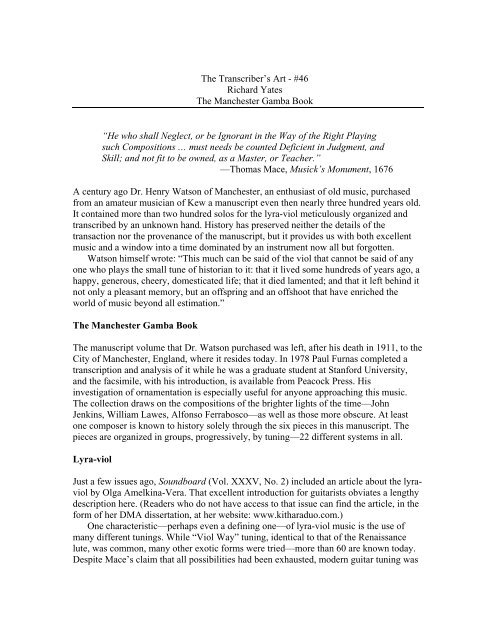


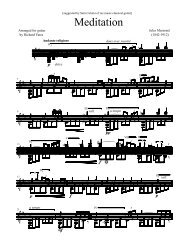
![Finale 2005b - [BWV846-Prelude in C.MUS]](https://img.yumpu.com/43978887/1/190x245/finale-2005b-bwv846-prelude-in-cmus.jpg?quality=85)
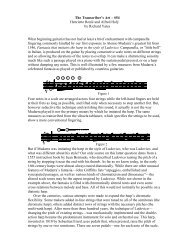
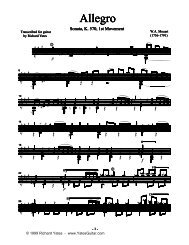

![Finale 2005b - [AirG-TAB.MUS] - Richard Yates Classical Guitar ...](https://img.yumpu.com/37104901/1/190x245/finale-2005b-airg-tabmus-richard-yates-classical-guitar-.jpg?quality=85)

